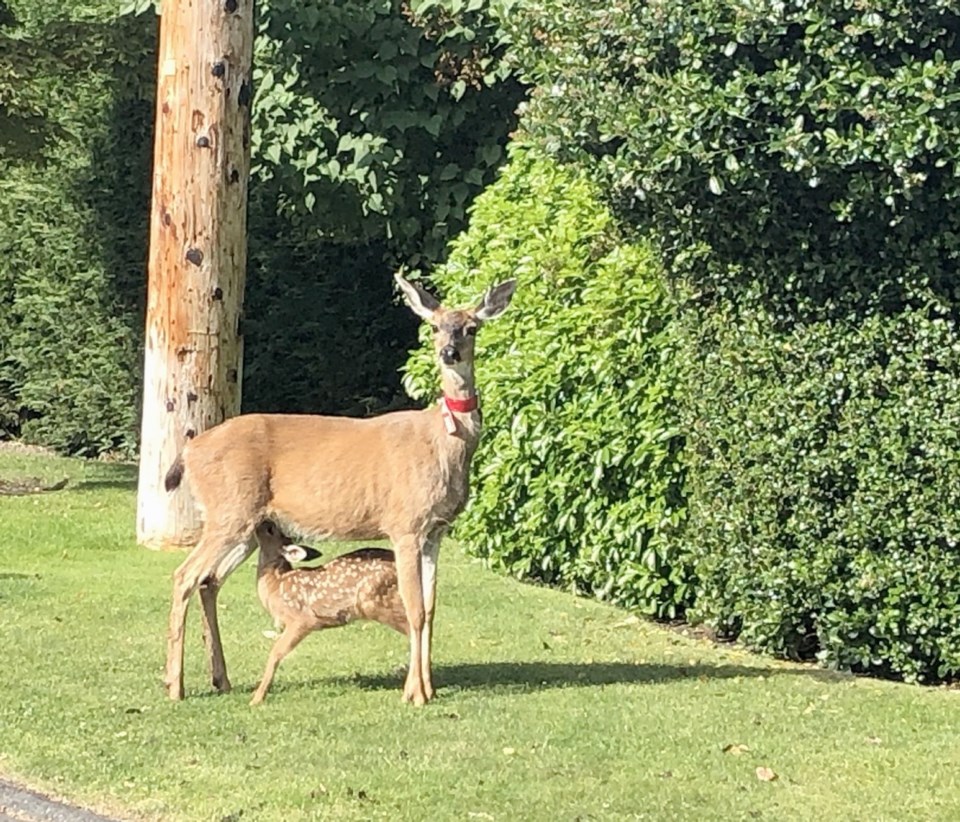It’s early days, but Oak Bay’s birth-control program for deer appears to be working.
None of the 60 does that were vaccinated last fall with an immunocontraceptive have given birth thus far.
“It seems really promising that things are working out the way we hoped they would,” wildlife biologist Alina Fisher said Monday. “But we’ve literally just entered fawning season, so we’ll have a better idea of how successful it is in two weeks.”
Fisher is part of the research team for the Oak Bay Deer Project, a first-of-its-kind study that is attempting to reduce the number of wild deer in the municipality. Oak Bay, the province and a citizen-led anti-cull group called the Urban Wildlife Stewardship Society have been working on the project, aimed at helping to solve the urban deer problem.
In September 2019, 60 does were inoculated with an immunocontraceptive by wildlife veterinarian Dr. Adam Hering and a group of volunteers. The does were darted with a sedative, then a primer dose of the vaccine was injected by hand. Two to six weeks later, the deer were given a booster.
The project also includes a control group of 20 does that were collared, but not vaccinated. Their collars were replaced early this spring with coloured collars and pink tags with red reflective tape on them.
“We needed to have that control group to know for sure whether the immunocontraceptive was keeping the does from having fawns,” said Fisher. “Of the photos I have seen so far, the fawns are only with the control group of does, which are the ones we want.”
When the deer-management program began in 2017, 39 motion-sensor cameras were installed along trails in Oak Bay to photograph wandering deer.
The researchers are downloading the photos periodically to see if a doe that has given birth is a control doe, said Fisher.
The team is also receiving photographs from the public and is happy to receive more.
“It’s been great. We’ve had a lot of community engagement to help us figure out if this is effective or not,” said Fisher. “Any photos and sightings from the public are a huge help.”
After giving birth, a doe will leave her fawn in a place where it is sheltered or where it blends in really well, while she leaves to feed, said Fisher.
“It’s for protection in their first few days when they’re at their most vulnerable. Mum can be away up to 12 hours at a time feeding. Leaving her fawn, which has no scent, in a space away from her, actually helps to reduce the chance of predation.”
Even though Fisher thinks there will be far fewer fawns this spring, she’s reminding the public to be careful because there’s a risk someone might stumble across one.
“Use your best judgment in trying to avoid them. Leave them be. Avoid eye contact with a doe that might have a fawn with her. Stay quiet and give them space,” she advised.
Oak Bay police are also asking people to be careful around deer at this time of year, because they go into protective mode when they have fawns.
On Thursday, a woman reported an aggressive deer in the 2400-block of Hamiota Street. The woman was walking her dog and told police she had to take refuge at another house until someone chased the deer away with a lawn chair.
If a deer approaches, police say, dog owners should pick up their pets and try to back away, while putting something between them and the deer.
After the data from the study is collected, it will be analyzed and the updated information will be given to the District of Oak Bay and made public so people know how effective the program is, Fisher said.
“But I’m not sure what the turnaround will be on that, because we have quite a bit of data to compile. We’re working on trying to get it out as fast as we can.”
Anyone with photographs of deer and fawns in Oak Bay is invited to email them to Fisher at info@uwss.ca.



